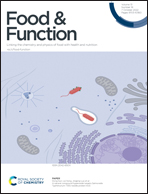Adherence to the Chinese dietary guidelines and metabolic syndrome among children aged 6–14 years†
Abstract
The role of diet in the development of childhood metabolic syndrome (MetS) has not been clearly elucidated. This study aims to investigate the association between the adherence to the Chinese Dietary Guidelines (CDG) 2016 and the presence of MetS and its components in Chinese children aged 6–14 years. This study is a cross-sectional study using data from the 2017 and 2019 Nutrition and Health Surveillance in Primary and Secondary school students of Beijing (NHSPSB). MetS was diagnosed using the recommended criteria for Chinese children. Diet was assessed using 3 consecutive days of 24-hour dietary recalls in addition to weighing household cooking oils and condiments. The Chinese Healthy Eating Index (CHEI) score was calculated based on the CDG 2016. Generalized estimating equations (GEEs) were used to estimate the correlation between the CHEI score and the likelihood of MetS and its components. A total of 2092 records (1048 in 2017 and 1044 in 2019), derived from 1835 children, were included. A higher CHEI score, which reflects better adherence to the CDG 2016, was correlated with a lower presence of MetS (per 5-point increment: OR = 0.85, 95% CI: 0.75–0.97) and low HDL-C (per 5-point increment: OR = 0.89, 95% CI: 0.80–0.99). Regarding the CHEI components, higher scores in dark vegetables and cooking oils were also associated with reduced likelihood of MetS (per 1-point increment: OR = 0.79, 95% CI: 0.67–0.93 for dark vegetables; OR = 0.91, 95% CI: 0.86–0.96 for cooking oils). This study suggests that better adherence to the CDG 2016 may reduce the risk of MetS in Chinese children aged 6–14 years.

- This article is part of the themed collection: Food & Function HOT Articles 2022


 Please wait while we load your content...
Please wait while we load your content...